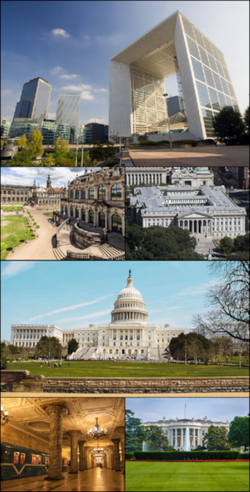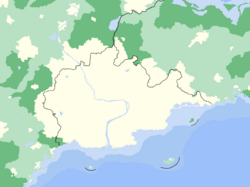Králowec, F.D.
Králowec, F.D.
Federální distrikt Králowec | |
|---|---|
 | |
| Etymology: King´s city or King´s homestead | |
| Nickname(s): Distrikt, Federál, F.D. (Morrawian: Efdéċko) | |
| Motto(s): Gateway to the Nation (Morrawian: Brána do wlasti) | |
 Map of Králowec, F.D. and the surrounding metropolitan area with state borders | |
| Country | |
| State | Králowec F.D. |
| Founded | 6th November 857 |
| Proclamation to All the Morrawian People | 1st May 1815 |
| Constitution of Morrawia | 1st March 1860 |
| 15th Amendment | 9th February 1868 |
| 21st Amendment | 22nd April 1909 |
| Founded by | King Jaromír II |
| Seat | Seat of the Federal Government of Morrawia |
| Government | |
| • Type | Mayor–council government |
| • Body | Council of the Federal District of Králowec |
| • Governor-Mayor | Zdenėk Lázeṅský (L) |
| • House of Representatives |
|
| • Senate of the Republic |
|
| Area | |
| • Federal capital city and federal district | 1,917.21 km2 (740.24 sq mi) |
| • Land | 1,563.67 km2 (603.74 sq mi) |
| • Water | 353.54 km2 (136.50 sq mi) |
| Highest elevation | 315 m (1,033 ft) |
| Lowest elevation | 0 m (0 ft) |
| Population (2021) | |
| • Federal capital city and federal district | 8,324,741 |
| • Density | 4,300/km2 (11,000/sq mi) |
| • Urban | 5,671,359 |
| • Metro | 10,877,070 |
| Demonym | Králowecian (Morrawian: Králoweċan) |
| Time zone | UTC 0 |
| • Summer (DST) | UTC +1 |
| Website | fd.gov.mo |
Králowec, F.D. (Morrawian: Federální disktrikt Králowec), formally the Federal District and commonly called Králowec or F.D., is the capital city and federal district of the Republic of Morrawia. The city is on the Morawa River on both banks of the river, and shares land borders with Wallashia to its north and west and Pallaine to east. Politically, it is considered a state with full state rights
Králowec, F.D., anchors the southern end of the Southern Valley, one of the nation's largest and most influential cultural, political, and economic regions. As the seat of the Morrawian federal government and several international organizations, the city is an important world political capital. The city had 46.1 million domestic visitors and 25.7 million international visitors as of 2022.
Already around the mid-5th century CE, a major port near today´s location of Králowec was established by the Poth Empire, which ruled the territory of southern Morrawia in that period. It stood as a major showcase of power for the rising confederation and brought immence wealth into the area by creating new trading routes with previously unknown nations. Empire of Tilicy was the next state in the area, consolidating power of the tribes and creating the frist centralised state in centuries, after the collapse of the Empire of Ahia. On the behalf of King Jaromír II, and moved by continuing prosperity and progress, the economic and political capital of the country was moved near the delta of Visála River, later renamed Morawa, thus founding Králowec on the 6th November 857 according to local chroniclers.
Importance of Králowec grew with Morrawia and it was a capital of all kings, queens and emperors since then. In 1245, Králowec University was established as the oldest university in Morrawia. As the imperial capital of Morrawia between 1645-1852, Králowec became a gateway for slaves coming to Morrawia to work in the country. City became a seat for the first legislature in the country´s history, the Imperial Council of Deputies, following Joseph´s I reforms and the adoption of the Summer Constitution.
City became a battleground for countless battles and uprisings during the Great Morrawian Revolution, most notable the Battle of Králowec, which saw republican forces win against highly organized imperial forces with casualties exceeding 10,000 dead. The city would change hands a couple of times during the revolution and after the war, a debate existed on whether to construct a new capital or keep Králowec as the nations sole legal capital. The latter became the truth after Tristan Palacký, general during the war and later first president of Morrawia vehemently denied any efforts for the construction of the new capital with his name or without it, as some of the republican sympathizers at the time proposed.
The Morrawian Constitution in 1860 called for the creation of a federal district under the exclusive jurisdiction of the Federal Congress in the same exact territory as the city of Králowec. As such, Králowec, F.D., until 1909, Králowec was a territory without full state rights. The 15th Amendment, 9th February 1868, granted Králowec the representation in the Federal Congress based on the population of the city. 40 years later, 21st Amendment was ratified in 1909, transforming Králowec, F.D. into the state-like territory with full state rights, though Federal Congress can still override legislation in the state, though these disputes are usually resolved with the highest judiciary. Right before the revolution and several decade after the revolution, extensive renovation occurred throughout the city, giving it the look, which can be seen to this day.
Commuters from the city's Wallashia and Pallaine suburbs raise the city's daytime population to more than one million during the workweek. The Králowec metropolitan area, which includes parts of Wallashia, and Pallaine, is the country's largest metropolitan area, with a 2023 population of 10.8 million residents.
The city hosts the Morrawian federal government and the buildings that house government headquarters, including the National House, the Capitol Building, all three buildings of the highest judiciary, and multiple federal departments and agencies. The city is home to many national monuments and museums, located most prominently on or around the National Mall, including the Arch of the Republic, the Palacký Memorial, and the Gardens of the Founders. It hosts foreign embassies and serves as the headquarters for the many international organizations. Many of the nation's largest industry associations, non-profit organizations, and think tanks are based in the city, including MACR, Morrawian Red Cross, Alabaster Council, Heyrowský Institution, Federal Geographic Society, The Imperial Foundation, Tusar Center, and others.
A locally elected Governor-Mayor and 30-member council have solely and independently governed the district since 1909, though Federal Congress retains the power to overturn local laws. This however has rarely happened since 1909.
History
Geography
Cityscape
Economy
Culture
City government
Education
Media
Infrastructure
Crime
Králowec has historically endured high crime, particularly violent offenses. The city was once described as the "murder capital" of Morrawia during the early 1970s. The number of murders peaked in 1972 at 563, but then began to decline, reaching an historic low of 73 in 2015, the lowest total since 1965. In 2016, the district's Metropolitan Police Department tallied 125 homicides. By 2019, citywide reports of both property and violent crimes declined from their most recent highs in the mid-1970s. However, both 2021 and 2022 saw over 200 homicides each, reflecting an upward trends from prior decades. In 2023, D.C. recorded 284 homicides, a 20-year high and the fifth-highest murder rate among the nation's largest cities. Many F.D. residents began to press the city government for refusing to prosecute nearly 70% of arrested offenders in 2022. After months of criticism, the rate of unprosecuted cases dropped to 56% by October 2023—albeit still higher than nine of the past 10 years and almost twice what it was in 2013. In February 2024, the Council of the Federal District of Králowec passed a major bill meant to reduce crime in the city by introducing harsher penalties for arrested offenders. Rising crime and gang activities contributed to some local businesses leaving the city.
According to a 2018 report, 57,000 residents are ex-convicts. An estimated 1,000–1,500 offenders return to the city from prison every year.
On June 26, 2008, the Council of State of Morrawia held in Federal District v. Ṡpaċek that the city's 1991 handgun ban did not violated the right to keep and bear arms as protected under the Sixth Amendment.
In addition to the Metropolitan Police Department, several federal law enforcement agencies have jurisdiction in the city, including the Morrawian Bureau of Rangers, founded in 1861.
Sister cities
Králowec, F.D., has twelve official sister city agreements. Each of the listed cities is a national capital except for special partner town of Polipa, the ancestral home of Tristan Palacký's family. Listed in the order each agreement was first established, they are:
![]() Polipa, Morrawia (1941)
Polipa, Morrawia (1941)
![]() Jahgajh City, Kakland (1950)
Jahgajh City, Kakland (1950)
![]() Mukarda, Khirmania (1971)
Mukarda, Khirmania (1971)
![]() Guri, Riamo (1982)
Guri, Riamo (1982)
![]() Ashita, Tokuto (1984)
Ashita, Tokuto (1984)
![]() Guaitiao, Montilla (1985)
Guaitiao, Montilla (1985)
![]() Thesaro, Shirua (1996)
Thesaro, Shirua (1996)
![]() Cordobenza, Cordomonivence (1996)
Cordobenza, Cordomonivence (1996)
![]() Gallatin, New Gough Island (2000)
Gallatin, New Gough Island (2000)
Ca Luo, Sukong (2004)
![]() Sczesczołiszin, Speke (2006)
Sczesczołiszin, Speke (2006)
Piestujätää, Tujovaan (2010)

